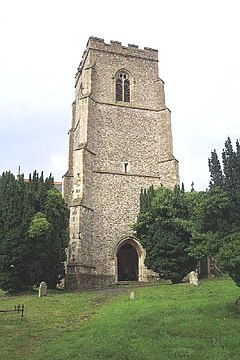Historical Writings
The earliest known mention of Clopton is a record in the Domesday Book as "Clopetuna". [6]
In the early 1870s, it was described in John Marius Wilson's Imperial Gazetteer of England and Wales as:
- "...a parish in Woodbridge district, Suffolk; 3½ miles N by W of Bealings r. station, and 4 NW of Woodbridge. Post town, Grundisburgh, under Wood-bridge. Acres, 2, 074. Real property, £4, 012. Pop., 407. Houses, 84. The property is divided among a few. Part of the land is common. The living is a rectory in the diocese of Norwich. Value, £720.* Patron, Mrs. E. Taylor. The church is old but good; and there are charities £34." [7]
In 1887, John Bartholomew also wrote an entry on Clopton in the Gazetteer of the British Isles with a much shorter description:
- "Clopton, par., E. Suffolk, 4 miles NW. of Woodbridge, 2074 ac., pop. 382; P.O.; contains C. Hall." [8]
The BBC Domesday Project described Clopton in a similar yet more detailed fashion to the Gazetteer entries in 1986:
- "Clopton is a small village situated approximately 7 miles from Ipswich and 4 miles from Woodbridge in the county of Suffolk. The area consists mainly of arable farms together with a small amount of housing. To the east side of Clopton is an area of disused airfield which now has a small amount of light industry. To the west side is the East Suffolk College of Agriculture and Horticulture at Otley; again consisting mainly of farmland. The village is served by a Post Office, bus service, mobile tradesmen and has 3 churches. There are no schools or shops in Clopton." [9]
Industry
In 1831, the decennial census found that over three-quarters of Clopton's population worked in agriculture, with most of these being labourers employed by farmers. Other than this, the parish had a small number describing themselves as being employed in "retail and handicrafts," and an even smaller number being "professionals" or "other." [12]
In 1844, White's Directories for Suffolk listed 13 farmers, a shoemaker, blacksmith and wheelwright. [6] The 1912 edition listed 19 farmers, a farm bailiff, postmaster, schoolmaster, builder, shoemaker, wheelwright, storekeeper, grocer, hardware merchant, furniture remover/carrier, publican and insurance agent. [6]
By 1881, the Parish as a whole, while still mostly reliant on agriculture to provide work, had diversified into other industries. Around this time, the presence of women in the workplace had increased somewhat as well: though these industries were small in comparison to the almost entirely male-dominated agricultural sector, in the 1881 census women outnumbered men in the 'Domestic Services and Offices' and 'Dress' occupation orders. Nonetheless, while 75 men reported working in agriculture, only 9 women reported having an occupation at all. [13]




